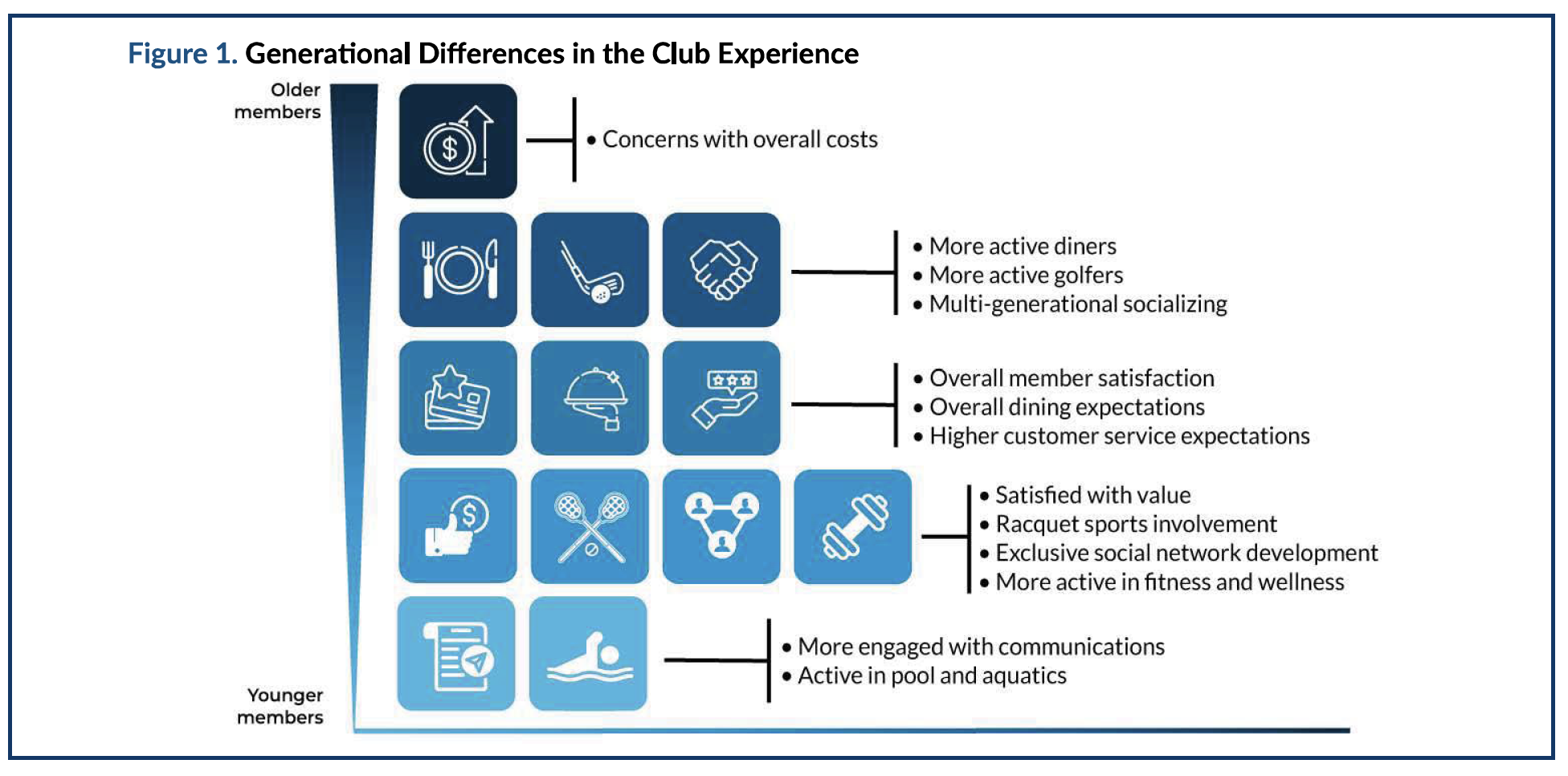Board Brief
July 2025
Designed for Club Board of Directors

Inside this Issue:
-
By the Numbers: Strategies for Connecting Members Across Generations
Private clubs face growing generational divides due to differing priorities. Older members often focus more on value for dues, while younger members seek modern amenities and new experiences. Clubs can create connections through social events and effective communication to bridge these gaps. -
Best Practices: Effective Onboarding for New Members
As many clubs experience a regeneration of long-tenured members aging out of their clubs, there is a steady demand from Generation X and Millennials to join private clubs. One matter on which most club members, regardless of generation, agree is that new members need to be properly indoctrinated to the club’s rules and practices. -
Insights: Building a Culture of Collaborative Leadership
Today’s most effective leaders succeed not through isolated efforts but through the collective power of the teams they build. Investing in people and creating an environment where talent is nurtured leads to long-term growth and excellence. -
External Influences: Workforce Impact
Explore the latest legislative and regulatory actions related to federal taxation of tips, the 2024 independent contractor rule, and the 2024 overtime rule. -
CMAA News & Announcements: 2025 Club Executive of the Year: Call for Nominations
Annually, Club Management magazine honors a high-performing club management professional who exemplifies excellence in leadership with the Club Executive of the Year Award. -
CMAA News & Announcements: Upcoming Governance & Leadership Symposium on July 30
Do you want to be better prepared for your role as a club leader? Attend CMAA’s next Governance & Leadership Symposium on July 30.

By the Numbers: Strategies for Connecting Members Across Generations
Private clubs face growing generational divides due to differing priorities. Older members often focus more on value for dues, while younger members seek modern amenities and new experiences. Clubs can create connections through social events and effective communication to bridge these gaps.
The 2025 edition of the Club Leaders’ Perspective Report from CMAA and GGA Partners dives into these generational challenges. Key insights from the Report include:
- Leaders indicate that concerns over the value received from dues were of focus for older members, while younger members focused on club usage.
- When comparing generational differences, overall satisfaction was considered most similar between generations, while social interests were the most different.
- Regular social events that bring members together and effective communication are seen as the most successful ways to overcome generational differences.
The following is excerpted from the 2025 Club Leaders’ Perspective Report:
Generational Challenges
The widening gap between generational expectations is a challenging landscape for private clubs. Each age group has its own priorities, presenting obstacles for a cohesive club experience. Economic factors play a significant role, as membership demand and fees often attract a wealthier or younger generation to many clubs. This shift results in diverse perspectives on what private clubs should offer, sparking a clash between cherished traditions and modern desires.
Understanding Club Expectations
Club leaders were asked to evaluate various statements regarding club experiences to determine whether they resonated more with younger members, were similar across generations, or resonated more with older members.

Figure 1 demonstrates the significant differences that exist between generations as perceived by club leaders.
Older members, viewed as more active golfers and diners, had concerns about overall costs. Fifty-eight percent of respondents indicated this was a more significant concern, compared to just 17 percent for younger members. While concerns about overall membership costs are an issue for all ages of member, they are particularly pressing for older members.
Differences and Similarities
Pressure from both older and younger members underscores the need for innovative strategies to develop a more adaptable value proposition that can meet the needs of both segments. Clubs can start by identifying common ground among members to provide universal value. Seventy-three percent of respondents indicate that members of all ages share a common interest in socializing across generals and 56 percent share similar customer service expectations.
CMAA members may access their complimentary copy of the full report through CMAA Connect in the Best Practices Exchange Community Library in the CMAA Annual Reports folder.

Best Practices
Effective Onboarding for New Members
As many clubs experience a regeneration of long-tenured members aging out of their clubs, there is a steady demand from Generation X (those born between the years of 1965 to 1980) and Millennials, whose birth years range from 1981 to 1996 to join private clubs. One matter on which most club members, regardless of generation, agree is that new members need to be properly indoctrinated to the club’s rules and practices.
Several keys for new member orientation programs are:
- Traditions of the Club—Most private clubs are proud of their histories and traditions for annual club events, such as the member-guest and the club championship. It is important for new members to understand what those events represent and how one is allowed to participate. Note should be given to any events in which new members are not allowed for unique reasons.
Your club should have a club history which documents the founding ideals that set current expectations. Note should be made to address how the club may have changed since its founders began the club. Important and high-profile events are attractive to some members and should be described for all the club’s activities. - Participation Guidelines for Club Events—New members do not want to make an embarrassing mistake so provide detailed description of how one registers for certain events and what, if any, limitations there may be for membership type or tenure in the club.
- Club Charges and Tipping—Explain how the club’s billing cycle works and show what their first invoice from the club will look like. Identify which amounts are fixed and why; show which amounts will vary due to seasonality, usage, or membership type.
Address the club’s tipping policy head-on. Most club members do not understand their club’s tipping policy. Explain your club’s service charge. Is it in addition to or in lieu of transactional gratuities? Importantly, explain how much of the tip amount is paid to the server. - Disciplinary Practices and Expectations—Discipline in many clubs slipped during the pandemic and is a matter of concern to many members who believe that it is others’ poor behavior that should be addressed.
Three important points related to member discipline orientation:
-
- Authority—New members should understand that the club’s bylaws give disciplinary authority to the club’s board. In some clubs this authority is assigned to the manager of the club.
- Process—New members want to understand what happens if they misstep. Who will contact them? And what happens sequentially. Emphasize that the club’s process is to be fast, firm, and fair… and see that the club acts on that basis.
- Consistency—Most clubs derail disciplinary standards when the clubs are inconsistent with enforcement. When one member is allowed a pass and another member receives discipline, there will be a sense of unfairness or discrimination.
Patient and thorough orientation gives new members a great start.
Submitted by Henry DeLozier, Partner, GGA Partner

Insights
Building a Culture of Collaborative Leadership
Leadership development is essential for creating a thriving, successful organization. At the heart
of this development is fostering a culture of collaborative leadership, where team members are
encouraged to grow, contribute, and support one another in achieving shared goals. Today’s most effective leaders succeed not through isolated efforts but through the collective power of the teams they build. Investing in people and creating an environment where talent is nurtured leads to long-term growth and excellence.
As Walt Disney famously said, “You can build the most amazing place on earth, but without people, it will fail.”
The Importance of Investing in Leadership Development
Club boards often prioritize investments in the General Manager, but what about the rest of the management team? Too often, education budgets take a back seat to capital ventures or amenity enhancements. However, building a robust education budget that includes the entire management team is vital for long-term success. By prioritizing leadership development, you create a culture of growth and continuous learning, pushing the management team to achieve higher results and foster a more competitive, engaged organization.
A common concern is, “What if we invest in development and don’t see immediate results?” The truth is that the investment will still pay off. If the development doesn’t yield results, you’ll have gained clarity on the strengths and weaknesses within your leadership team. This enables you to make informed decisions and adjustments to ensure future success.
Leadership Development Doesn’t Have to Be Expensive
For smaller organizations with limited budgets, investing in leadership development can seem daunting. However, a strong education and development program doesn’t have to come with a hefty price tag. Here are some creative, low-cost ideas to help you foster leadership growth within your team:
- Leadership Retreats
Many organizations host annual board retreats to work through strategic plans and set yearly goals. But have you considered hosting a similar retreat focused on leadership development? A leadership retreat, where management teams collaborate, strategize, and invest in each other’s growth, is a highly effective (and often cost-effective) way to strengthen your team. Bringing in an outside facilitator or expert to guide these sessions can provide valuable insights while offering a team-building experience. - Maximizing Conference Opportunities
When your Golf Pro or other management members attend industry conferences or expos, are they simply attending the trade shows, or are they participating in educational sessions as well? Encourage them to bring back what they’ve learned to the entire leadership team. This practice helps reinforce the value of ongoing learning and ensures that knowledge is shared across the organization.
- Utilizing Local Resources
Local industry chapters often offer affordable educational opportunities throughout the year, including virtual options that eliminate the need for travel expenses. These resources are an excellent way to expand your team’s knowledge without breaking the bank. Plus, requiring attendees to share what they’ve learned with the broader team ensures that the organization benefits from these experiences.
- Consultant-Led Group Education
Many consultants offer group education sessions at reduced or even free rates. These programs are often open to board members and management teams, covering various leadership and organizational topics. Take advantage of these opportunities to inspire your team and expose them to new perspectives and best practices.
- Sharing Industry Publications
How often do you share industry publications with your management team and board members? These resources provide valuable insights and can be easily distributed to foster learning without additional costs. Having leaders share their thoughts on the articles helps create a learning-focused environment.
- In-House Learning Presentations
Some of the most impactful leadership development comes from within the organization. Encourage department leaders to dive deep into specific topics they are passionate about and share their findings with the team. Consider creating a competition for the best presentation, with a prize for the winner. This helps build a culture of learning and encourages individuals to take ownership of their personal development.
- Leadership Meetings with a Growth Focus
Leadership meetings often focus on immediate club or organizational issues, but they also present an opportunity for growth and development. Consider shifting your agenda to include educational components, where team members are encouraged to lead discussions, share insights, and learn from each other.
- Individual Development Plans
Creating Individual Development Plans (IDP) for each leader is a structured way to focus on growth and development. Collaboratively identifying strengths and opportunities for improvement, then setting actionable goals, is key to ensuring leaders have clear paths for growth. Regular check-ins and even tying IDP achievements to incentives, like bonuses, can help keep the process on track and motivate leaders to put in the effort required for success.
- Industry Books as Learning Tools
Books on leadership and management are a relatively inexpensive resource that can provide valuable insights for your team. By reading and discussing industry books as a group, leaders can share perspectives and engage in meaningful dialogue that benefits everyone.
- Peer-to-Peer Learning
One of the most valuable, yet often overlooked, opportunities for leadership development is spending time with other managers at different clubs. Gaining insights from their experiences and seeing how they manage operations can provide invaluable lessons. This type of peer learning often only requires the cost of travel but can yield powerful growth opportunities.
Leadership development is a continuous journey, and creating a high-performing team requires a long-term commitment to investing in people. From cost-effective local resources to more comprehensive programs, there are countless ways to grow and inspire your leadership team without breaking the bank. The key is to make leadership development a priority, involve the entire management team in the process, and cultivate a culture of learning.
When you invest time, effort, and resources into developing your leaders, the benefits will be felt throughout the organization. You’ll see improvements in leadership performance and build a team that is empowered, engaged, and ready to take your organization to new heights.
Insights by Jeffery Murray, CCM, CAM, FMP, Strategic Club Solutions

External Influences
Workforce Impact
Senate Passes No Tax on Tips Act
On May 20, the US Senate passed S129, the No Tax on Tips Act. The legislation creates a new federal income tax deduction for qualified tips.
Tips are defined as cash tips (1) received by an employee in an occupation that customarily receives tips, and (2) reported by the employee to the employer for purposes of withholding payroll taxes. The legislation directs the Treasury Department to publish a list of qualified occupations.
The deduction would be available to individuals when they pay their federal taxes annually and would be limited to no more than $25,000. It is an above-the-line deduction so individuals would not need to itemize their deductions to take advantage of it.
Employees with compensation exceeding the IRS definition of highly compensated, currently $160,000 in 2025, would be ineligible.
Additionally, the legislation expands the business tax credit for tips related to beauty services, including barbering, hair care, nail care, esthetics, and body and spa treatments. Currently the existing business tax credit is only available for tips related to food or beverage provision, delivery, or service.
A notable 63.2 percent of clubs have transitioned away from traditional tipping models to service charges for member dining. However, clubs may soon find themselves reevaluating their approach.
The bill will now head to the House of Representatives for consideration. The House passed a similar measure in the 2025 tax package.
DOL Suspends Enforcement of 2024 Independent Contractor Rule
In May, the Department of Labor (DOL) issued updated guidance on how to determine whether an individual is an employee or independent contractor to its field staff, signaling that it will not be enforcing the 2024 independent contractor rule. The DOL plans to reconsider the 2024 final rule and is expected to make substantial changes.
The guidance directs field agents not to apply the 2024 rule and to instead focus on DOL’s Fact Sheet #13 (version 2008) and Opinion Letter FLSA2019-6. These documents focus on the “economic reality” as the distinguishing factor of examining the relationship. An employee “is dependent on the business which he or she serves” and an independent contractor is a “personal who is engaged in a business or his or her own.” Additionally, both documents highlight other factors that have been considered significant by the Supreme Court in litigation including:
- The extent to which the services rendered are an integral part of the employer’s business.
- The permanence of the relationship.
- The amount of the individual’s investment in facilities and equipment.
- The nature and degree of control by the employer.
- The individual’s opportunities for profit and loss.
- The amount of initiative, judgment, or foresight in open market competition with others required for the success of the individual.
During this transition period, clubs are advised to review the changes and be mindful of any existing state or local laws before determining employee/independent contractor classification.
2024 Overtime Rule Appeal Withdrawn
In April, the Trump Administration halted its appeal of 2024 overtime rule. A federal judge vacated the rule in November 2024, invalidating the increased salary thresholds and triennial automatic updates. In December 2024, the Biden Administration announced that it would appeal the ruling.
This nationwide decision restored the previously established standards of $35,568 annually (or $684 weekly) for exempt employees and $107,432 annually for highly compensated employees) and suspended any further implementation of the 2024 rule.
With the suspension of the appeal, it is unlikely that additional overtime changes will occur as the Trump Administration set the previously established thresholds.
CMAA News & Announcements
2025 Club Executive of the Year: Call for Nominations
Annually, Club Management magazine honors a high-performing club management professional who exemplifies excellence in leadership with the Club Executive of the Year Award. Created 40 years ago as the Club Manager of the Year Award, today the distinction specifically recognizes top-level executives whose sustained contributions have had a significant impact on their clubs, communities, and the broader profession.
Today, the distinction highlights one club management professional annually who demonstrates mentoring, creates a supportive club culture, and sustains ongoing engagement with their local CMAA Chapter.
Help us honor an extraordinary club management professional who raises the bar in club management and within the CMAA community. CMAA welcomes and encourages nominations from diverse backgrounds and work experiences. Help us honor an extraordinary club management professional who has truly raised the bar in club management and within the CMAA community.
Please review the full criteria, nomination packet requirements, judging process, and notification information available online. All nomination materials must be received by September 10.

Upcoming Governance & Leadership Symposium on July 30
Do you want to be better prepared for your role as a club leader? Attend CMAA’s next Governance & Leadership Symposium on July 30.
These one-day, virtual events are specifically designed to bring together the GM/CEO/COO and their club’s Board Members for collaborative education and leadership development. These Symposiums offer actionable insights and tools to strengthen club governance, and you will walk away with a deeper understanding of your role and valuable strategies to improve your leadership contributions. Presented in partnership with KOPPLIN KUEBLER & WALLACE, a CMAA Executive Partner, these highly rated sessions provide a unique opportunity to gain new perspectives and foster stronger partnerships between club management and elected leaders.


